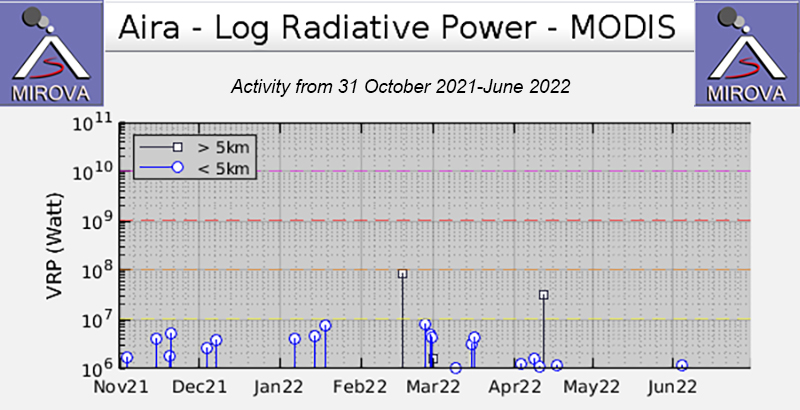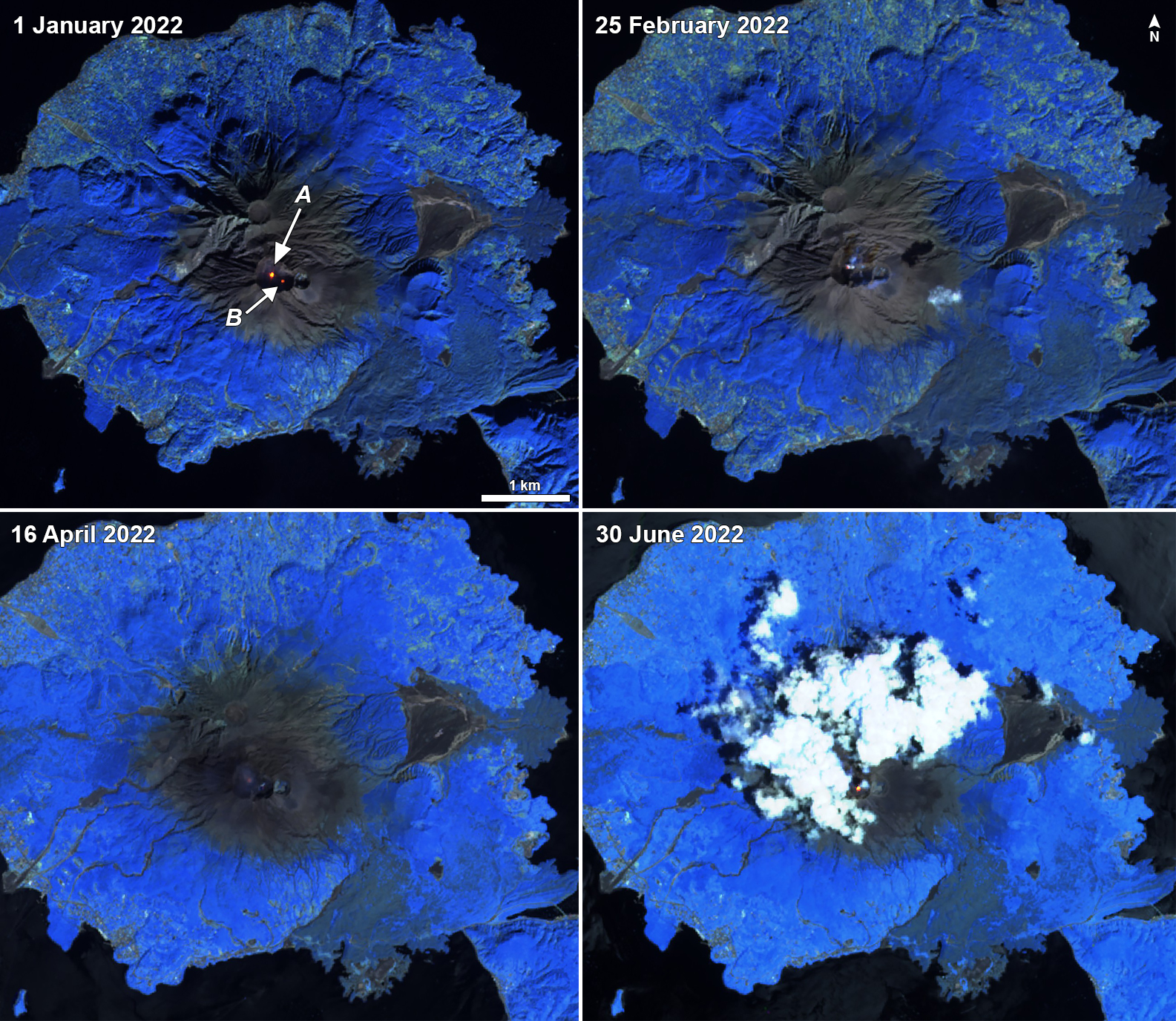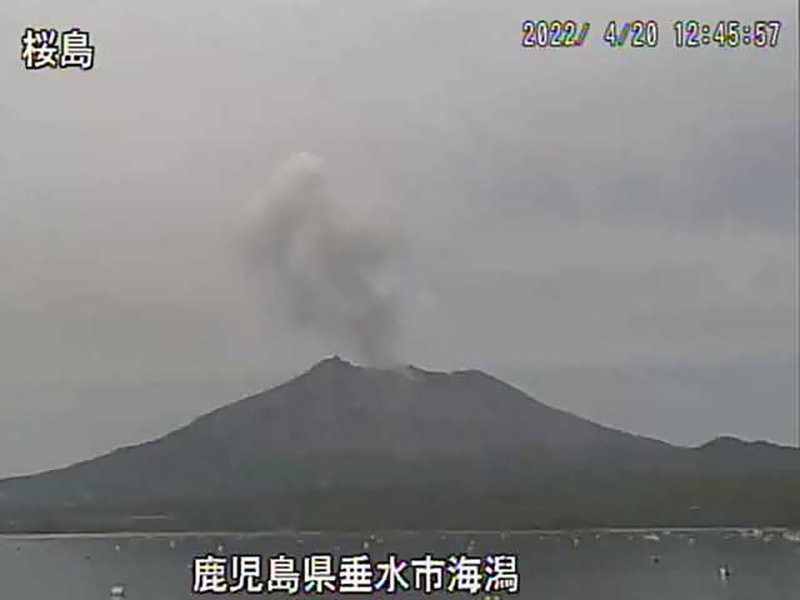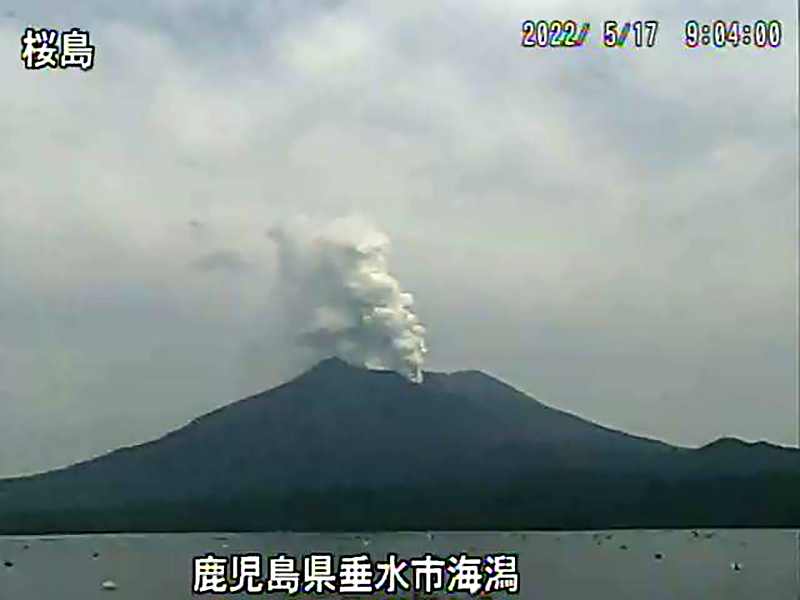Report on Aira (Japan) — July 2022
Bulletin of the Global Volcanism Network, vol. 47, no. 7 (July 2022)
Managing Editor: Edward Venzke.
Edited by Kadie L. Bennis.
Aira (Japan) Explosive events, plumes, minor ashfall, and crater incandescence during January-June 2022
Please cite this report as:
Global Volcanism Program, 2022. Report on Aira (Japan) (Bennis, K.L., and Venzke, E., eds.). Bulletin of the Global Volcanism Network, 47:7. Smithsonian Institution. https://doi.org/10.5479/si.GVP.BGVN202207-282080
Aira
Japan
31.5772°N, 130.6589°E; summit elev. 1117 m
All times are local (unless otherwise noted)
The Aira caldera in the northern half of Kagoshima Bay contains the active post-caldera Sakurajima volcano near the southern tip of Japan’s Kyushu Island. Eruptions date back to the 8th century, which have deposited ash on Kagoshima, 8 km from the summit. The Minamidake summit cone and crater has had persistent activity since 1955; the Showa crater on the E flank has also been intermittently active since 2006. More recent activity has consisted of minor ash emissions, low thermal activity, and ashfall events (BGVN 47:01). The current eruption period began in late March 2017, characterized by some explosions and ash emissions in the Minamidake crater. This report updates information from January through June 2022 using monthly activity from the Japan Meteorological Agency (JMA), the Tokyo Volcanic Ash Advisory Center (VAAC), and various satellite data.
Low levels of activity from the Minamidake crater during this reporting period dominantly consisted of volcano-tectonic earthquakes, eruption plumes, and nighttime incandescence, with the addition of some explosions, ashfall, and sulfur dioxide emissions (table 27). Reports of activity in the Showa crater mainly described occasional white gas-and-steam emissions. Thermal activity remained at low levels throughout the period (figure 127), though summit crater incandescence was frequently reported at night during clear weather. Some thermal anomalies at the Minamidake crater were visible in Sentinel-2 infrared satellite imagery (figure 128).
Table 27. Number of monthly explosive events, days of ashfall, area of ash covered, and sulfur dioxide emissions from Sakurajima’s Minamidake crater at Aira during January-June 2022. Note that smaller ash events are not listed. Ashfall days were measured at Kagoshima Local Meteorological Observatory, and ashfall amounts represent material covering all the Kagoshima Prefecture. Data courtesy of JMA monthly reports.
| Month | Explosive events | Days of ashfall | Ashfall amount (g/m2) | SO2 emissions (tons/day) |
| Jan 2022 | 5 | 1 | Less than 0.5 | 400-1,000 |
| Feb 2022 | 0 | 2 | Less than 0.5 | 700-1,700 |
| Mar 2022 | 0 | 0 | 0 | 800-1,300 |
| Apr 2022 | 0 | 0 | 0 | 500-1,300 |
| May 2022 | 0 | 3 | Less than 0.5 | 500-1,700 |
| Jun 2022 | 1 | 0 | 0 | 800-1,200 |
There were 103 volcanic earthquakes reported during January, a decrease from December 2021 (136). Additionally, a field survey reported that 400-1,000 tons/day (t/d) of sulfur dioxide emissions were emitted during the month, compared to December (600-1,200 t/d). Eruption plumes rose 1-2 km above the crater and drifted E and SE following eruption events detected on 1, 7, and 18 January. Nighttime crater incandescence was also visible on these days, based on surveillance cameras. On 7 and 18 January large volcanic blocks were ejected 600-900 m and 1-1.3 km from the Minamidake crater. Two eruptions were detected at the Minamidake crater on 28 January, one of which was described as an explosion; at 1319 a plume rose as high as 3.4 km above the crater and material traveled 1.3-1.7 km from the Minamidake summit crater (figure 129); crater incandescence accompanied this event. That same day, a field survey reported that ashfall was observed in Arimura Town (753 g/m2) and Kurokami-cho, according to JMA (figure 129).
Activity during February was relatively low and consisted of 22 volcanic earthquakes and eruption events at 1620 on 13 February and 1540 on 15 February. A field survey reported that 700-1,700 t/d of sulfur dioxide emissions were measured during this month. The event on 13 February the eruption plume rose 1 km above the crater and drifted SE and on 15 February the plume rose 1.3 km above the crater and drifted E. Similar low activity during March and April was characterized by 36 and 37 volcanic earthquakes, respectively, and intermittent crater incandescence, based on surveillance camera data. Sulfur dioxide emissions were 800-1,300 t/d during March and 500-1,300 t/d during April. An eruption event on 17 March produced a small plume that rose 600 m above the crater rim, and one on 20 April sent a plume 900 m above the crater (figure 130).
During May, the number of volcanic earthquakes detected increased to 154 and the sulfur dioxide emissions ranged from 500 to 1,700 t/d. An eruption at 1453 on 3 May generated a plume that rose 1 km above the crater. On 15 May an eruption event at 1141 produced a plume that rose 1.2 km above the crater. Another eruption event on 17 May occurred at 0900 and produced plumes that rose 1.5 km above the crater (figure 131). Nighttime crater incandescence also accompanied this event, based on high-sensitivity surveillance cameras. Volcanic tremors were detected during 17-19 May and JMA reported that there was a notable increase in the number of tremors on 19 May. Intermittent incandescence was visible at the Minamidake crater throughout the rest of the month. Activity during June remained consistent, with frequent nighttime incandescence and 57 volcanic earthquakes. Daily sulfur dioxide emissions were 800-1,200 t/d during June. Eruption events reported by JMA on 27, 28, and 29 June generated eruption plumes that rose 1.2-1.6 km above the crater and drifted NE. An explosion on 27 June at 1221 produced an eruption plume that rose 1.6 km above the crater and ejected volcanic blocks 600-900 m from the Minamidake crater.
Geological Summary. The Aira caldera in the northern half of Kagoshima Bay contains the post-caldera Sakurajima volcano, one of Japan's most active. Eruption of the voluminous Ito pyroclastic flow accompanied formation of the 17 x 23 km caldera about 22,000 years ago. The smaller Wakamiko caldera was formed during the early Holocene in the NE corner of the caldera, along with several post-caldera cones. The construction of Sakurajima began about 13,000 years ago on the southern rim and built an island that was joined to the Osumi Peninsula during the major explosive and effusive eruption of 1914. Activity at the Kitadake summit cone ended about 4,850 years ago, after which eruptions took place at Minamidake. Frequent eruptions since the 8th century have deposited ash on the city of Kagoshima, located across Kagoshima Bay only 8 km from the summit. The largest recorded eruption took place during 1471-76.
Information Contacts: Japan Meteorological Agency (JMA), 1-3-4 Otemachi, Chiyoda-ku, Tokyo 100-8122, Japan (URL: http://www.jma.go.jp/jma/indexe.html); MIROVA (Middle InfraRed Observation of Volcanic Activity), a collaborative project between the Universities of Turin and Florence (Italy) supported by the Centre for Volcanic Risk of the Italian Civil Protection Department (URL: http://www.mirovaweb.it/); Sentinel Hub Playground (URL: https://www.sentinel-hub.com/explore/sentinel-playground).






